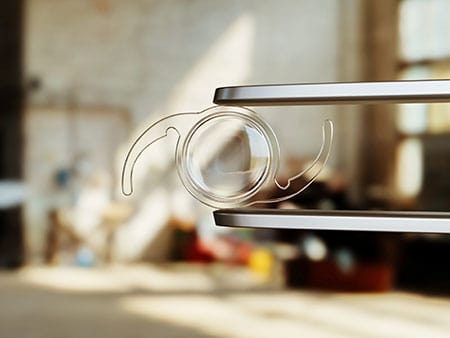
Vision correction procedures go beyond laser eye surgery. Refractive lens exchange (RLE) is a safe and effective alternative to LASIK for patients with thin corneas, presbyopia, and dry eyes. The procedure removes the clear natural lens in the eye and replaces it with an intraocular lens (IOL) implant powered to the patient’s unique refractive errors. New advancements in lens implants in 2024 may offer better visual outcomes and patient experiences.
Our renowned ophthalmologists at Laser Eye Center™ take pride in using the latest technologies and techniques to enhance vision and eye health. Our eye surgeons have performed over 500,000 successful procedures and are leaders in refractive and cataract surgery. We are the launching pad for many of the region’s best eye surgeons, fulfilling the entire patient-care journey from optometry to eye surgery.
Artificial Intelligence in Ophthalmology
Artificial intelligence (AI) refers to computer systems that perform tasks usually done by a human being and have a range of abilities. Machine-learning AI systems follow instructions using statistical models and algorithms that make conclusions on data patterns without human intervention. Deep learning AI machines use multiple layers of processing to form higher-level observation data. These methods combined create convolutional neural networks that accomplish four goals, including:
- Receive data
- Assign importance to data points
- Cluster similar data
- Recognize, process, and classify images
Ophthalmology is uniquely suited for integrating AI technologies because this field is heavily image- and data-based and offers a wide range of potential applications for AI. Some AI tools are already applicable to data points about diabetic retinopathy, age-related macular degeneration, glaucoma, cataracts, keratoconus, and other eye conditions.
AI-Driven IOL Power Calculator
Vision outcomes from refractive lens exchange come down to the lens power of the IOL, which is based on measurements taken during an eye exam. Ordering the chosen IOL with these data points requires the eye surgeon to input the axial length, keratometry, and other details multiple times. Human error and inaccurate measurements can occasionally happen with this system. The European Society of Cataract and Refractive Surgeons (ESCRS) has created an AI-driven tool that uses deep learning models to predict the axial length position after RLE or cataract surgery to provide better vision for patients.

To use the ESCRS IOL calculator, the eye surgeon inputs the measurements once and then compares that data to seven of the modern online formulas and their outputs. The program provides data-driven approaches to predicting the best IOL power for sharper vision. The organization recently launched a similar IOL program to calculate toric lens measurements for astigmatism patients. Another tool is on the horizon for post-refractive surgery outcomes in 2024.
Machine learning and AI tools have great potential to reduce refractive “surprises” after RLE or cataract surgery. A 2019 study evaluated refractive results for 171,930 cataract extractions and found that about 74% of patients had vision within .5 diopters (D) of their vision goals. Researchers used the AI tool and a partial least squares regression (PLSR) model to evaluate data from 368 eyes with various axial lengths and short or long eyes and estimate the ideal lens power. The results indicated the AI and PLSR models could potentially improve visual outcomes for RLE patients and provide visual acuity within .24 D to .28 D of the desired refraction.
These tools could offer superior results compared to conventional IOL power calculation formulas, and researchers say this is only the beginning of enhancing RLE outcomes with new technologies.
A Digital Operating Room
Digital operating rooms increase access to patient information and diagnostic data in the operating theater, allowing eye surgeons to streamline their workflow. Whether digital information is incorporated into a microscope or on a screen, these technologies improve care from pre-operative assessment to post-operative care. A digital operating room allows patients to access informational material before their procedure and add documents and details to their patient records.
Most patients expect an online portal to ask questions or voice concerns throughout their care. These new options can enhance the patient experience and provide eye surgeons with more details during the procedure, creating a win-win solution with an easier flow of information between doctors and patients.
Incorporating New Technologies

Small-scale applications using a vast library of data can profoundly impact patients’ lives, especially with better vision through IOL lens power prediction. Detailed, raw data from these diagnostic tools and a digital operating room can improve patient outcomes, the patient experience, and the workflow of the ophthalmology practice.
Our team at Laser Eye Center is excited about these emerging technologies for refractive lens exchange, cataract surgery, and other applications. Ophthalmology is an ever-changing field, and our eye surgeons and staff stay at the forefront of these advancements.
Learn more about refractive lens exchange by scheduling a consultation at Laser Eye Center in Los Angeles, California. Contact our office at (800) 805-2737.
Sources:
- https://europe.ophthalmologytimes.com/view/in-2024-data-driven-tools-will-shape-cataract-and-refractive-surgery
- https://www.escrs.org/eurotimes-articles/ai-could-reduce-refractive-surprises/
- https://www.ncbi.nlm.nih.gov/pmc/articles/PMC9240552/
Schedule your free consult today
Click here to learn moreGet started on your journey to clearer, crisper vision with Laser Eye Center™. Our expert team of doctors are trained and skilled in the latest technology and methods for laser vision correction. To learn more about our state-of-the-art All Laser LASIK technology or about All Laser LASIK itself, contact us today. Schedule your FREE All Laser LASIK consultation by calling today.

